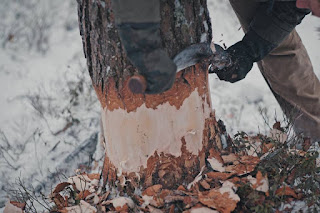挪威樹皮環切技術 Ringbarking in Norwegian
挪威樹皮環切技術 Ringbarking in Norwegian
在現今木材工業中,為了保護木材,會在木材注入各種化學藥品讓木材使用時間更久。但千年前,挪威人用樹皮環切的技術,已證明可以使木材保存長達千年。這種古老技術如果好好立用,可以使木材消費形態改變,會獲得更耐用的木材材料可以使用,減少砍代樹木的數量。
挪威樹皮環切技術是從地面上環切樹皮,並移除樹幹上方一些樹皮,阻止水份與糖份的運送。正確執行後,樹木會經歷一個緩慢死亡的過程,樹會耗盡糖分,並在受傷的地方填充更多樹脂,且木材慢慢的變乾,這方法所製造的木材不易裂開,也不會縮小,會穩定保持好幾個世紀。
執行時間是在冬天前,隔年夏天結束時樹體開始死亡,下個冬天根被凍結前,就可以收了,這是原木建築取材料最好的時間。
In today’s logging and lumber industry, it is the new normal to treat nearly every piece of lumber used with various chemicals in an attempt to preserve the wood. However, this is often a temporary “fix” and these shortcuts have proven to be ineffective over time. But there are tried and true methods of harvesting and preserving logs and lumber the natural way. These techniques have been used throughout Scandinavia for centuries and have been proven to preserve logs for as many as 1000 years without the slightest signs of rot or decay.
The magnitude of this sustainability is unparalleled by any other industry. If we simply take a moment to look back and apply the knowledge our forefathers knew (before it’s too late), we can turn around today’s modern consumer based home building industry and greatly affect the environment, our planet, and even our personal health, for the better.
There are two known techniques of preserving the wood with resin and taking all the sugars out of it a year before felling it. They can be applied both on the growing coniferous trees or just one of these.
First is the “Ringbarking in Norwegian” technique. Removing the bark on the lower part around the tree 10” wide about 15-20” from the ground. Like all vascular plants, trees use two vascular tissues for transportation of water and nutrients: the Xylem (also known as the wood) and the Phloem (the innermost layer of the bark). Ringbarking results in the removal of these two vascular tissues and can permanently stop further transportation of sugars and water. This knowledge executed correctly will cause the tree to go through a slow death process, removing all sugars and drying the tree at the same time before it is even felled. The result is a material/log that is ready to use, more stable, experiences less cracking, shrinking and will last for many centuries.
The other one is the “Blæking in Norwegian” (Injuring/Scaring) technique. “Injured” meaning – the bark is chopped off randomly with an axe so that the tree can start to heal itself and push all the sugars out of the sapwood and fill/replace it with resin and antiseptics. It is an almost forgotten technique in modern forestry. This is one of the ways logs, in which log-buildings have been prepared throughout Northern Europe for thousands of years, make them stronger and resilient to rot as the sugars and water in the sapwood are in turn replaced with resin and various antiseptics. There is common to call such prepared pines an “Amberwood”. It takes a whole cycle of 4 seasons until the tree is ready to be felled after injuring/scaring or ringbarking.
It will start to die by the end of next summer (if you injure it in the winter before) and then by the next winter it is ready for felling. It should be felled when the roots are frozen and when the new moon is approaching based on the old carpenters calendar when is the best time to fell the trees for log buildings and timber frames.
資料來源:
Northmen 臉書





























0 意見:
張貼留言